Nyheter
Gold’s Old Ceiling or a New Floor?
Publicerad
7 år sedanden

Gold Comment ”Gold’s Old Ceiling or a New Floor?” by Joe Foster, Portfolio Manager/Strategist
Key Takeaways
- As the U.S. dollar strengthened, gold bullion declined in May while gold stocks saw little movement.
Signs of a late-cycle economy and geopolitical risks continue to mount with gold maintaining its resiliency while waiting for a market catalyst. - The price trend of gold indicates a new trading pattern in early ’19 with $1,365 per ounce as either the old ceiling or a new floor.
Gold Declines as U.S. Dollar Strengthened in May
Gold remained resilient in May, as the U.S. dollar strengthened considerably. The U.S. Dollar Index (DXY)1 gained 2.4% and closed the month at its highs for the year, driven by new fears of an Italian debt default and EU breakup. Populist parties from the left and right are attempting to form a coalition government that would likely drive Italy further into debt and to promote initiatives that would enable Italy to exit the euro. Italian President Sergio Mattarella blocked the coalition, which effectively suspended their plans. We expect to see the coalition make further attempts to gain power, which should keep the markets on edge for the foreseeable future.
As the DXY gained, the gold price fell to its low for the year of $1,282 per ounce on May 21. Gold subsequently advanced into month-end as the Italian situation rose to a boil, ending at $1,298.52 per ounce for a monthly decline of $16.83 (1.3%).
Gold Responds to Systemic Risks, Not Headlines
It seems that every time new, scary headlines emerge, press articles declare that gold no longer serves as a safe haven.2 The Italian political crisis is the latest case in point. The evolving situation in Italy is supportive of gold, as shown by its resilience against a strong move in the U.S. dollar. However, anyone expecting a big move from gold fails to understand the fundamentals of the gold market. Gold responds to genuine global systemic risks. These are risks that can have a negative financial impact on just about everyone personally and/or professionally, i.e., risks that bring excessive inflation or deflation, currency, debt, banking crises, or geopolitical events that impact trade and commerce. Localized risks that are the subject of most headlines do not elicit a strong response from gold.
Stock, bond, and currency markets reacted violently to the Italian news. However, the gold market remained calm, which tells us that, so far, this is not the systemic event that the headlines are implying. The chances of an EU breakup are still very small. The euro has survived Greece and Brexit. Gold price action indicates the EU will survive Italy as well. If the situation reaches global systemic proportions, we are sure there will be a strong response from the gold market. Until then, investors should be wary of the implications of the seemingly endless stream of scary headlines.
Gold can also have a different response locally that many American reporters ignore. In euro terms, gold gained €25.62 (2.4%) in May, making a new yearly high. Italians holding gold have a safe haven hedge.
Like gold, gold stocks saw little net movement in May, as the NYSE Arca Gold Miners Index (GDMNTR)3 advanced 0.2% and the MVIS Global Junior Gold Miners Index (MVGDXJTR)4 gained 0.3%.
Indications of Late-Cycle Economy Remain
Many indicators continue to tell us the economy is very late in the cycle. The current economic expansion is now the second longest on record, surpassed only by the tech boom of the 1990s. Convertible bond issuance by tech companies is on pace to challenge the levels last seen in 2000. The stock market is struggling to return to its highs, even though S&P 500 companies spent $158 billion buying back stock in the first quarter, a record pace according to a report from the S&P Dow Jones Indices. Delinquency rates for subprime auto loans have surpassed the levels of the global financial crisis. Financial regulation has come full cycle, as Congress passed a deregulation bill in May and the Fed advanced a proposal to ease the Volcker rule,5 both aimed at reducing crisis-era regulations. The Fed is tightening, but rates are still far below normal at this stage of the cycle. Accommodative monetary policies continue to promote asset price inflation. In May, the Rockefeller Collection auction surpassed all expectations, raising $832 billion, nearly doubling the previous record for a collection, which was set in 2009.
Economic down-cycles are normally a healthy and somewhat painful way of cleansing the economy of bad debts, dead beat companies, and crooks. The extraordinary risk facing the financial system is that central banks have little to no room to stimulate when the current cycle comes to an end. There is no capacity for fiscal stimulus either and sovereign debt service could become very problematic. Fiscally, the developed world is looking more like Italy all the time.
The $1,365 Question
The second half of 2018 should be very interesting for the gold market. The chart shows the gold price has formed a wedge or pennant pattern that has been in place for several years. The positive aspect of this pattern is the trend of higher lows. Fundamentally, gold has been resilient, gaining strength from escalating geopolitical risks and uncertainties. The negative aspect is the ceiling that has formed around $1,365. There has not been a strong catalyst to take gold to a new higher trend line. Investors have been frustrated by this range bound price action, while speculators have been put off by the decreasing volatility. The apex of the wedge occurs in early 2019; therefore, we believe it is inevitable that gold will begin to establish a new trading pattern by year end. Similar patterns can be seen in the GDM and MVGDXJ indices and the price of silver.
Gold Price Chart, 2013 – 2018
Source: Bloomberg. Data as of May 31, 2018. Past performance is not indicative of future results.
Without a second half catalyst, gold will probably drift sideways, falling below the lower trend line and further eroding confidence in the metal. However, in the second half of the year, we could see catalysts that may boost gold to a higher range that draws new attention from investors. To start, the geopolitical risks that have been supportive of gold are likely to continue – tensions in the Middle East and North Korea, and uncertainty surrounding Trump administration policies. With the economy firing on all cylinders and lofty commodities prices, an inflation surprise is possible. Mid-term elections in the U.S. may result in destabilizing shifts in power if the Democrats prevail. Leadership changes in Italy are set to bring added risks to European banks, sovereigns, and the euro. Last but not least, signs that the post-crisis expansion is nearing its end may emerge.
Gold tested the low end of its trading range in May. As gold has shown price weakness ahead of Fed rate increases, we expect gold to continue to drift around the bottom of the range until the expected rate increase on June 12. Futures positioning and flows into gold bullion exchange traded products suggest gold is poised for another post-Fed meeting rally. If gold retests $1,365 in the second half, will it again act as a ceiling or become a new floor? We wish we could know the answer to such questions.
IMPORTANT DISCLOSURE
*Please note that the information herein represents the opinion of the portfolio manager and these opinions may change at any time and from time to time. Not intended to be a forecast of future events, a guarantee of future results or investment advice. Historical performance is not indicative of future results; current data may differ from data quoted. Current market conditions may not continue. Non-VanEck proprietary information contained herein has been obtained from sources believed to be reliable, but not guaranteed. No part of this material may be reproduced in any form, or referred to in any other publication, without express written permission of VanEck. © 2018.
1U.S. Dollar Index (DXY) indicates the general international value of the U.S. dollar. The DXY does this by averaging the exchange rates between the U.S. dollar and six major world currencies: Euro, Japanese yen, Pound sterling, Canadian dollar, Swedish kroner, and Swiss franc.
2Safe haven is an investment that is expected to retain its value or even increase its value in times of market turbulence.
3NYSE Arca Gold Miners Index (GDMNTR) is a modified market capitalization-weighted index comprised of publicly traded companies involved primarily in the mining for gold.
4MVIS® Global Junior Gold Miners Index (MVGDXJTR) is a rules-based, modified market capitalization-weighted, float-adjusted index comprised of a global universe of publicly traded small- and medium-capitalization companies that generate at least 50% of their revenues from gold and/or silver mining, hold real property that has the potential to produce at least 50% of the company’s revenue from gold or silver mining when developed, or primarily invest in gold or silver.
5The Volcker Rule refers to a part of the Dodd–Frank Wall Street Reform and Consumer Protection Act, originally proposed by American economist and former United States Federal Reserve Chairman Paul Volcker to restrict United States banks from making certain kinds of speculative investments that do not benefit their customers.
by Joe Foster, Portfolio Manager and Strategist
With more than 30 years of gold industry experience, Foster began his gold career as a boots on the ground geologist, evaluating mining exploration and development projects. Foster is Portfolio Manager and Strategist for the Gold and Precious Metals strategy.
Please note that the information herein represents the opinion of the author and these opinions may change at any time and from time to time.
IMPORTANT DISCLOSURE
*All company weightings, if mentioned, are as of April 30, 2018, unless otherwise noted
1The Producer Price index (PPI) is a family of indexes that measures the average change in selling prices received by domestic producers of goods and services over time.
2The Consumer Price Index (CPI) is a measure that examines the weighted average of prices of a basket of consumer goods and services, such as transportation, food and medical care. It is calculated by taking price changes for each item in the predetermined basket of goods and averaging them.
3NYSE Arca Gold Miners Index (GDMNTR) is a modified market capitalization-weighted index comprised of publicly traded companies involved primarily in the mining for gold.
4MVIS® Global Junior Gold Miners Index (MVGDXJTR) is a rules-based, modified market capitalization-weighted, float-adjusted index comprised of a global universe of publicly traded small- and medium-capitalization companies that generate at least 50% of their revenues from gold and/or silver mining, hold real property that has the potential to produce at least 50% of the company’s revenue from gold or silver mining when developed, or primarily invest in gold or silver.
Important Disclosures
This commentary originates from VanEck Investments Limited (“VanEck”) and does not constitute an offer to sell or solicitation to buy any security.
VanEck’s opinions stated in this commentary may deviate from opinions presented by other VanEck departments or companies. Information and opinions in this commentary are based on VanEck’s analysis. Any forecasts and projections contained in the commentary appear from the named sources. All opinions in this commentary are, regardless of source, given in good faith, and may only be valid as of the stated date of this commentary and are subject to change without notice in subsequent versions of the commentary. Any projections, market outlooks or estimates in this material are forward-looking statements and are based upon certain assumptions that are solely the opinion of VanEck. Any projections, outlooks or assumptions should not be construed to be indicative of the actual events which will occur.
No investment advice
The commentary is intended only to provide general and preliminary information to investors and shall not be construed as the basis for any investment decision. This commentary has been prepared by VanEck as general information for private use of investors to whom the commentary has been distributed, but it is not intended as a personal recommendation of particular financial instruments or strategies and thus it does not provide individually tailored investment advice, and does not take into account the individual investor’s financial situation, existing holdings or liabilities, investment knowledge and experience, investment objective and horizon or risk profile and preferences. The investor must particularly ensure the suitability of an investment as regards his/her financial and fiscal situation and investment objectives. The investor bears the risk of losses in connection with an investment.
Before acting on any information in this publication or report, it is recommendable to consult one’s financial advisor.
Forecasts, estimates, and certain information contained herein are based upon proprietary research and the information contained in this material is not intended to be, nor should it be construed or used as investment, tax or legal advice, any recommendation, or an offer to sell, or a solicitation of any offer to buy, an interest in any security. References to specific securities and their issuers or sectors are for illustrative purposes only and are not intended and should not be interpreted as recommendations to purchase or sell such securities or gain exposure to such sectors.
Each investor shall make his/her own appraisal of the tax and other financial merits of his/her investment.
Sources
This commentary may be based on or contain information, such as opinions, recommendations, estimates, price targets and valuations which emanate from: VanEck portfolio managers, analysts or representatives, publicly available information, information from other units or Companies of VanEck, or other named sources.
To the extent this commentary is based on or contain information emerging from other sources (“Other Sources”) than VanEck (“External Information”), VanEck has deemed the Other Sources to be reliable but neither the VanEck companies, others associated or affiliated with said companies nor any other person, do guarantee the accuracy, adequacy or completeness of the External Information.
Limitation of liability
VanEck and its associated and affiliated companies assume no liability as regards to any investment, divestment or retention decision taken by the investor on the basis of this commentary. In no event will VanEck or other associated and affiliated companies be liable for direct, indirect or incidental, special or consequential damages resulting from the information in this publication or report.
Risk information
The risk of investing in certain financial instruments, is generally high, as their market value is exposed to a lot of different factors such as the operational and financial conditions of the relevant company, growth prospects, change in interest rates, the economic and political environment, foreign exchange rates, shifts in market sentiments etc. Where an investment or security is denominated in a different currency to the investor’s currency of reference, changes in rates of exchange may have an adverse effect on the value, price or income of or from that investment to the investor. Past performance is not a guide to future performance. Estimates of future performance are based on assumptions that may not be realized. When investing in individual shares, the investor may lose all or part of the investments.
Conflicts of interest
VanEck, its affiliates or staff of VanEck companies, may perform services for, solicit business from, hold long or short positions in, or otherwise be interested in the investments (including derivatives) of any company mentioned in this commentary.
To limit possible conflicts of interest and counter the abuse of inside knowledge, the representatives, portfolio managers and analysts of VanEck are subject to internal rules on sound ethical conduct, the management of inside information, handling of unpublished research material, contact with other units of VanEck and personal account dealing. The internal rules have been prepared in accordance with applicable legislation and relevant industry standards. The object of the internal rules is for example to ensure that no analyst will abuse or cause others to abuse confidential information. This commentary has been prepared following the VanEck Conflict of Interest Policy.
Distribution restriction
This commentary is not intended for, and must not be distributed to private customers.
No part of this material may be reproduced in full or in part in any form, or referred to in any other publication without express written permission of VanEck. ©2017, VanEck.
Index Descriptions
All indices named in the commentary are unmanaged indices and include the reinvestment of all dividends, but do not reflect the payment of transaction costs, advisory fees or expenses that are associated with an investment in the Fund. An index’s performance is not illustrative of the Fund’s performance. Indices are not securities in which investments can be made.
Du kanske gillar
-


ETFmarknaden i Europa firar sitt 24-årsjubileum med tillgångar på två biljoner USD
-


GOLD ETC en börshandlad råvara utgiven av Boerse Stuttgart
-


GLDA ETC ger exponering mot fysiskt guld
-


Investing in Gold and Silver For Dummies
-


WisdomTree lanserar fysiskt uppbackad guld-ETC med ansvarsfullt ursprung
-


Guldfonder ser utflöden när investerare aktiverar risken
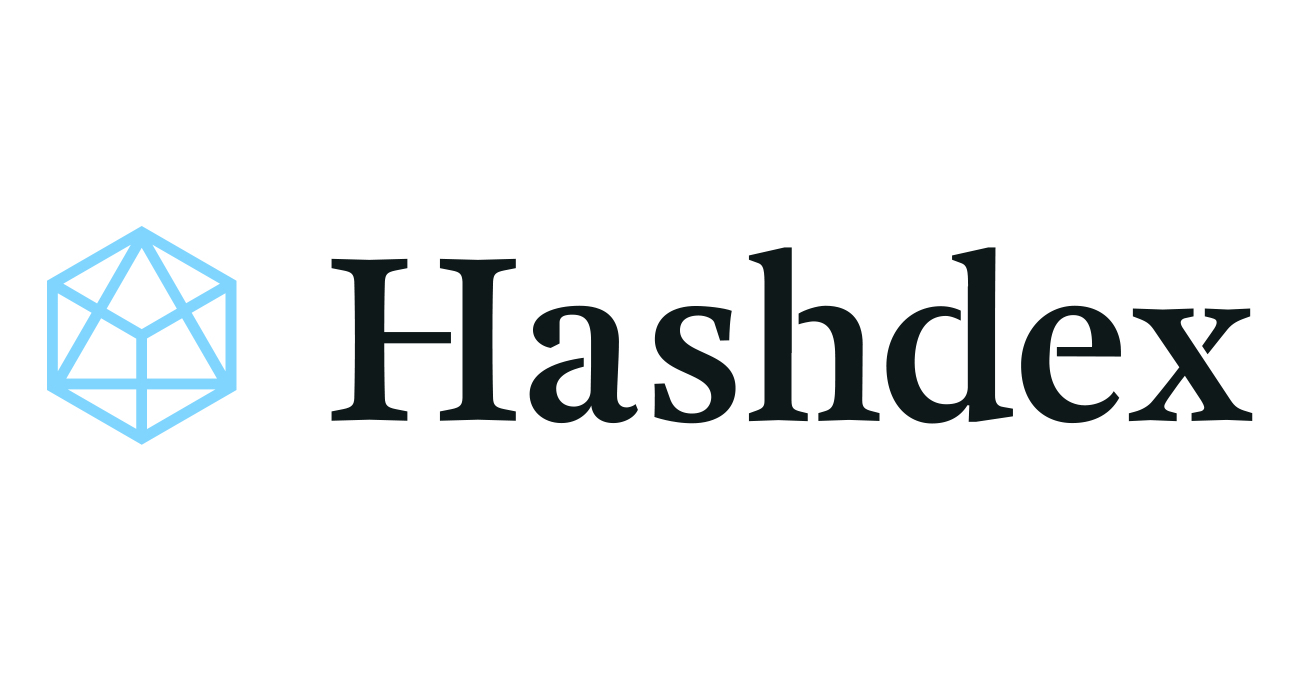
The impact of US tariffs continues to dominate market sentiment and risk assets, including crypto, struggled with this uncertainty throughout the month. The Nasdaq Crypto Index™ (NCI™) fell 4.46% in March as the S&P 500 and Nasdaq 100 dropped 5.63% and 7.61%, respectively.
Despite the macro uncertainty from Washington, US policymakers are continuing to embrace crypto in an unprecedented way, including launching a Bitcoin Strategic Reserve, Digital Asset Stockpile, and engaging in expansive work at the regulatory agencies and in Congress.
Our team spent the last week of the month in Washington, meeting with regulators to share our experiences and views on what’s most important for crypto investors in the US. In his latest Notes from the CIO, Samir Kerbage shares what he learned from these meetings and how investors should be thinking about the new regulatory regime in the US.
As always, we are greatly appreciative of your trust in us and are here to answer any questions you may have.
-Your Partners at Hashdex
Market Review
March was marked by the tariff dispute triggered by the Trump administration. Back-and-forth fiscal policies, threats, and retaliations dominated the month’s agenda. The uncertain macroeconomic environment put investors into a defensive stance and negatively impacted crypto assets. The Nasdaq Crypto Index™ (NCI™) closed the month down -4.46% after a period of high volatility. Major market indices, the S&P 500 and Nasdaq-100, also recorded steep declines of -5.63% and -7.61%, respectively. These concurrent drawdowns across equities and crypto underscored March’s broad market caution, as trade war uncertainty prompted investors to flee risk assets.
During times of uncertainty, it is common to observe increased correlation among different classes of risk assets. This pattern played out in March: the 6-month rolling correlation of monthly returns between the NCI™ and the Nasdaq-100 surged to roughly 0.91 (see chart below), its highest level since 2021, indicating that crypto assets were moving almost in lockstep with tech stocks. This spike in correlation confirms that crypto was behaving like a high-beta extension of the tech sector—an amplified version of the Nasdaq-100. The lack of clarity in the global landscape leads investors to reduce their risk exposure and seek protection, a movement known in financial markets as “risk-off” allocation.
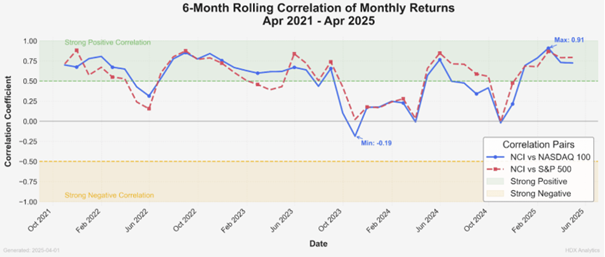
6-Month Rolling Correlation of Monthly Returns between the Nasdaq Crypto Index and Nasdaq-100 (Apr 2021–Apr 2025).
The chart illustrates how this correlation has been increasing since the American elections in November 2024 and spiked to approximately 0.91 in the most recent period—a multi-year high. This visual evidence reinforces the view that crypto assets have been moving closely in tandem with tech stocks, effectively acting as a high-beta version of the Nasdaq-100 during the March risk-off phase.
Following this trend, risk reduction was evident within the crypto asset class. Among the NCI’s constituents, Bitcoin (BTC) posted a decline of -1.93%, withstanding the downturn far better than other constituents such as Ether (ETH, -17.4%) and Litecoin (LTC, -34.6%). BTC’s relatively mild drop in this sell-off aligns with the idea that it increasingly trades like a high-beta proxy for large-cap tech. It still declined, but less severely, whereas smaller-cap crypto assets behaved more like speculative growth stocks and suffered outsized losses. The only exception to the negative results was Cardano (ADA), which surprised with a positive return of 3.88% despite no significant protocol developments during the month.
Thematic indices also faced a challenging environment. As highlighted in previous letters, smaller capitalization assets tend to suffer more during periods of market stress, mirroring how speculative small-cap stocks are hit hardest in equity sell-offs. The biggest negative highlight was the Digital Culture Index, which dropped -17.45%, followed by the Decentralized Finance (DeFi) and Smart Contract Platform (Web3) indices, which fell -16.73% and -12.07%, respectively. The Vinter Hashdex Risk Parity Momentum Index recorded a negative result of -8.26% but outperformed the three other thematic indices, benefiting from its high allocation in BTC and TRX (which gained 4.68%). The heavy weighting in BTC – the more resilient large-cap crypto – helped cushion this index, underscoring the relevance of the momentum factor in a well-diversified strategy during times of market stress.
The market remains on the lookout for the outcome of the fiscal policy discussions, hoping for a reduction in uncertainties and an end to the tariff war. That would likely mark the moment when investors regain their appetite for risk assets, including crypto assets. The U.S. government has also signaled interest in advancing the crypto agenda, a development that could drive the asset class to a new level of adoption. We remain confident in our positive outlook for the rest of the year and the long term.
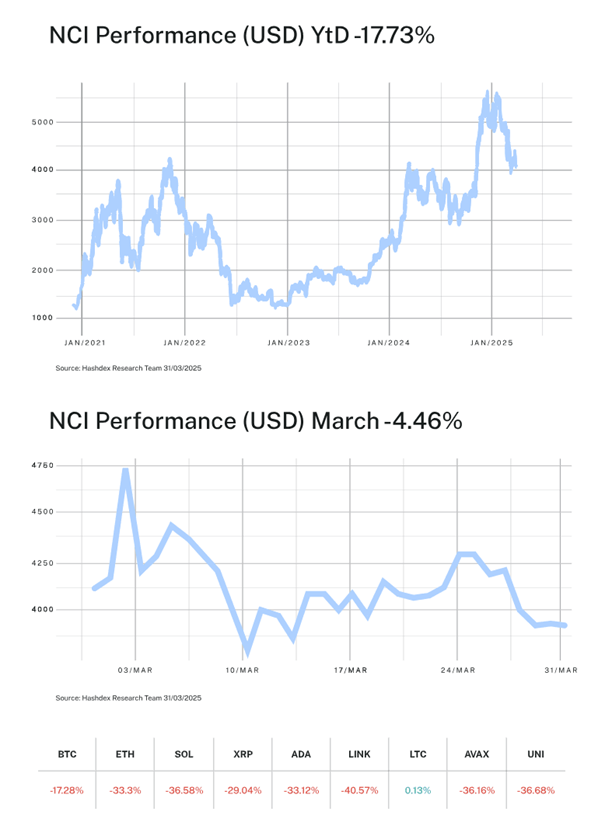
Top Stories
US creates Bitcoin Strategic Reserve and Digital Asset Stockpile
The Bitcoin Reserve will be capitalized with BTC owned by the Department of Treasury, which could further increase via new budget-neutral acquisitions. The stockpile will also include assets owned by the Treasury. This marks a major milestone, with the US government starting to integrate major crypto assets and continues the new administration’s work to lead the global crypto economy.
Stablecoins surpass $230 billion in market value
The total stablecoins market capitalization surpassed $230 billion amid institutional demand for dollar-backed digital assets. This showcases one of the most successful applications for crypto technology enhancing traditional financial payments. It could also pave the way for new use cases that require a strong and reliable global payment system.
FDIC eases banks’ ability to engage in crypto activities
The FDIC has rescinded previous guidelines which prevented financial institutions from engaging with crypto activities without prior sign-off. By removing bureaucratic hurdles, banks may more readily over crypto-related services, potentially leading to broader adoption and integration of digital assets into the financial system.
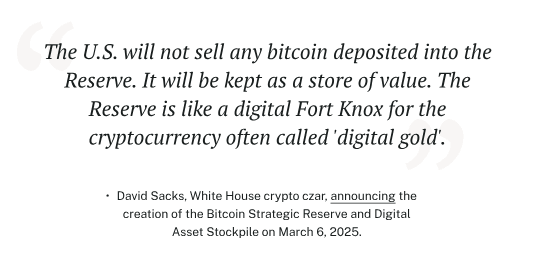

Nyheter
BSE8 ETF ger exponering mot företagsobligationer med förfall under 2028
Publicerad
10 timmar sedanden
5 april, 2025
Invesco BulletShares 2028 EUR Corporate Bond UCITS ETF EUR Acc (BSE8 ETF) med ISIN IE00079EUF59, försöker följa Bloomberg 2028 Maturity EUR Corporate Bond Screened-index. Bloomberg 2028 Maturity EUR Corporate Bond Screened Index följer företagsobligationer denominerade i EUR. Indexet speglar inte ett konstant löptidsintervall (som är fallet med de flesta andra obligationsindex). Istället ingår endast obligationer som förfaller under det angivna året (här: 2028) i indexet. Indexet består av ESG (environmental, social and governance) screenade företagsobligationer. Betyg: Investment Grade. Löptid: december 2028 (Denna ETF kommer att stängas efteråt).
Den börshandlade fondens TER (total cost ratio) uppgår till 0,10 % p.a. Invesco BulletShares 2028 EUR Corporate Bond UCITS ETF EUR Acc är den billigaste och största ETF som följer Bloomberg 2028 Maturity EUR Corporate Bond Screened index. ETFen replikerar det underliggande indexets prestanda genom samplingsteknik (köper ett urval av de mest relevanta indexbeståndsdelarna). Ränteintäkterna (kupongerna) i ETFen ackumuleras och återinvesteras.
Invesco BulletShares 2028 EUR Corporate Bond UCITS ETF EUR Acc är en mycket liten ETF med tillgångar på 6 miljoner euro under förvaltning. Denna ETF lanserades den 18 juni 2024 och har sin hemvist i Irland.
Produktbeskrivning
Invesco BulletShares 2028 EUR Corporate Bond UCITS ETF Acc syftar till att tillhandahålla den totala avkastningen för Bloomberg 2028 Maturity EUR Corporate Bond Screened Index (”Referensindexet”), minus avgifternas inverkan. Fonden har en fast löptid och kommer att upphöra på Förfallodagen.
Referensindexet är utformat för att återspegla resultatet för EUR-denominerade, investeringsklassade, fast ränta, skattepliktiga skuldebrev emitterade av företagsemittenter. För att vara kvalificerade för inkludering måste företagsvärdepapper ha minst 300 miljoner euro i nominellt utestående belopp och en effektiv löptid på eller mellan 1 januari 2028 och 31 december 2028.
Värdepapper är uteslutna om emittenter: 1) är inblandade i kontroversiella vapen, handeldvapen, militära kontrakt, oljesand, termiskt kol eller tobak; 2) inte har en kontroversnivå enligt definitionen av Sustainalytics eller har en Sustainalytics-kontroversnivå högre än 4; 3) anses inte följa principerna i FN:s Global Compact; eller 4) kommer från tillväxtmarknader.
Portföljförvaltarna strävar efter att uppnå fondens mål genom att tillämpa en urvalsstrategi, som inkluderar användning av kvantitativ analys, för att välja en andel av värdepapperen från referensindexet som representerar hela indexets egenskaper, med hjälp av faktorer som index- vägd genomsnittlig varaktighet, industrisektorer, landvikter och kreditkvalitet. När en företagsobligation som innehas av fonden når förfallodag kommer kontanterna som fonden tar emot att användas för att investera i kortfristiga EUR-denominerade skulder.
ETFen förvaltas passivt.
En investering i denna fond är ett förvärv av andelar i en passivt förvaltad indexföljande fond snarare än i de underliggande tillgångarna som ägs av fonden.
”Förfallodag”: den andra onsdagen i december 2026 eller sådant annat datum som bestäms av styrelseledamöterna och meddelas aktieägarna.
Handla BSE8 ETF
Invesco BulletShares 2028 EUR Corporate Bond UCITS ETF EUR Acc (BSE8 ETF) är en europeisk börshandlad fond. Denna fond handlas på Deutsche Boerse Xetra.
Det betyder att det går att handla andelar i denna ETF genom de flesta svenska banker och Internetmäklare, till exempel DEGIRO, Nordnet, Aktieinvest och Avanza.
Börsnoteringar
| Börs | Valuta | Kortnamn |
| XETRA | EUR | BSE8 |
Största innehav
| Namn | CUSIP | ISIN | Kupongränta | Vikt % |
| Volkswagen Leasing GmbH 3.875% 11/10/28 | D9T70CNQ3 | XS2745725155 | 3,875 | 2,19% |
| Swedbank AB 4.25% 11/07/28 | W94240FJ7 | XS2572496623 | 4,250 | 1,63% |
| ABN AMRO Bank NV 4.375% 20/10/28 | N0R37XLP3 | XS2613658710 | 4,375 | 1,62% |
| Carlsberg Breweries AS 4% 05/10/28 | K3662HDY6 | XS2696046460 | 4,000 | 1,60% |
| RCI Banque SA 4.875% 14/06/28 | F7S48DSE5 | FR001400IEQ0 | 4,875 | 1,59% |
| Booking Holdings Inc 3.625% 12/11/28 | — | XS2621007231 | 3,625 | 1,59% |
| Banco Santander SA 3.875% 16/01/28 | E2R99DB46 | XS2575952697 | 3,875 | 1,58% |
| Nordea Bank Abp 4.125% 05/05/28 | X5S8VP8C3 | XS2618906585 | 4,125 | 1,58% |
| E.ON SE 3.5% 12/01/28 | D2T8J8CT1 | XS2574873266 | 3,500 | 1,57% |
| General Motors Financial Co Inc 3.9% 12/01/28 | U37047BA1 | XS2747270630 | 3,900 | 1,57% |
Innehav kan komma att förändras

Det senaste veckan var den värsta veckan för världens aktiemarknader sedan covid-lockdown-kollapsen i mars 2020. Det var dessutom den värsta vecka för amerikanska aktier sedan covid-lockdown-kollapsen i mars 2020.
Det amerikanska referensindexet NASDAQ gick tillsammans med i Russell 2000, ett amerikanskt aktiemarknadsindex för småbolag i björnmarknadens territorium när dessa båda index fallit med över 20 procent från sina toppnoteringar. Samtidigt föll amerikanska Dow Jones med 2 200 punkter under fredagen.
Den grupp av företag som kallas för Mag 7 och har drivit börsuppgången på den amerikanska aktiemarknaden, tappade 1,4 biljoner dollar i börsvärde under veckan – det mest någonsin.
Fredagen den 4 april såh den högsta volymsessionen i historien på den amerikanska aktiemarknaden mätt som det totala antalet omsatta aktier på alla börser.
Det amerikanska VIX-indexet, känt som ”fear and greed-indexet” såg sin största veckorörelse sedan februari 2020. Det var också den värsta veckan för USAskreditmarknader sedan covid-lockdown-krisen, till och med värre än under SVB-bankkrisen.
Oljepriset kraschade med 11 procent under veckan, det största fallet sedan mars 2023 (SVB-kris / tillväxtskräck). Samtidigt rapporterade guldpriset den andra nedgångsvecka i år. Fredagen kursfall var den värsta dagen sedan november 2024. Priset på koppar såg sitt största fall sedan Lehman-kraschen i oktober 2008. Kryptovalutan Bitcoin rapporterade små vinster under veckan.

Spotlight on the tariff war

BSE8 ETF ger exponering mot företagsobligationer med förfall under 2028

En vecka för historieböckerna…

VGCF ETF investerar i korta företagsobligationer denominerade i euro

CBUV ETF satsar på Metaverse

Fonder som ger exponering mot försvarsindustrin

WisdomTree lanserar europeisk försvarsfond.

Warren Buffetts råd om vad man ska göra när börsen kraschar

De bästa börshandlade fonderna för tyska utdelningsaktier

Trumps återkomst får europeiska aktier att rusa
Populära
-

 Nyheter2 veckor sedan
Nyheter2 veckor sedanFonder som ger exponering mot försvarsindustrin
-

 Nyheter4 veckor sedan
Nyheter4 veckor sedanWisdomTree lanserar europeisk försvarsfond.
-

 Nyheter2 veckor sedan
Nyheter2 veckor sedanWarren Buffetts råd om vad man ska göra när börsen kraschar
-

 Nyheter3 veckor sedan
Nyheter3 veckor sedanDe bästa börshandlade fonderna för tyska utdelningsaktier
-

 Nyheter4 veckor sedan
Nyheter4 veckor sedanTrumps återkomst får europeiska aktier att rusa
-

 Nyheter5 dagar sedan
Nyheter5 dagar sedanSvenskarna har en ny favorit-ETF
-

 Nyheter2 veckor sedan
Nyheter2 veckor sedanHANetf lanserar Europa-fokuserad försvars-ETF
-
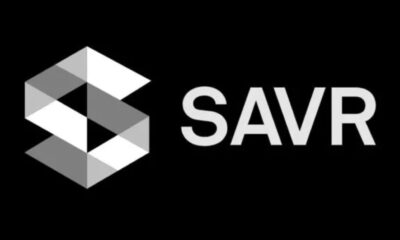
 Nyheter2 veckor sedan
Nyheter2 veckor sedanEn av de mest nedladdade finansapparna i Sverige


